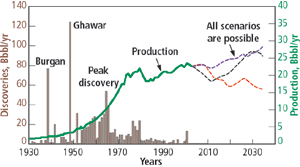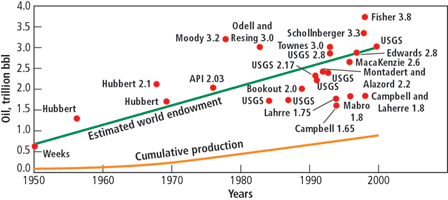Lies, damn lies and harbor spies. At the last session of the recent OTC, it was standing room only. A five-member panel presented all views on the contentious subject entitled: Hubbert's peak: fact or fiction? Jack Zagar gave a good presentation that epitomized the Hubbert-peakers' position. His themes were: non-conventional vs. conventional oil, the timing of discovered reserves and, of course, the peak of oil production, a.k.a. Hubbert's peak, is within a few years. As is typical for Hubbert peakers, I found the information highly selected for making the case of an impending peak, and logically explained as causal for that case, even though contrary explanations were available. For example, when showing discovered volumes by year, he stated, “backdating makes a colossal difference in the discovery trend.” But that same logic means that more-recent discoveries will grow in the future by that very same backdating method. So, while it looks important, the discovered-volumes-by-year graph shown below doesn't necessarily mean much: we will just have to wait and see how much future backdating adds to recent discoveries such as Kashagan East (13 Bbbl) and Azedegan (5 Bbbl). This in no way denies the simple fact that huge fields are easier to find, and would tend to be found first.
Matt Simmons noted that the track record of predicting just one oil or gas field has been abysmal, that it occurs only with hindsight, and generally only after a long period of time has passed. He cites that, in all likelihood, the North Sea is past peak (2001), as is what now appears to be the strung-out peak of North American gas production – in stark contrast to a National Petroleum Council report in 2000. The derisive term “paper barrels” that he and others use is a diversion. Are paper barrels any less real? Of course not. It doesn't matter whether reserve additions derive from new wildcats, field extensions, new compartments within existing fields, previously uneconomic satellites that now have supporting infrastructure, prices or increased recovery factors, because all of these result in real, additional oil brought to the surface that was previously unknown or thought unprofitable. I have no idea why so many elements of reserves growth are ignored or denied by the Peakers; perhaps it's because it just doesn't fit their impending doom scenario. Of these, two interrelated factors still have a long way to go: prices and recovery factors. The roughly 10% increase in recovery during the past two decades has resulted in about one-third of in situ oil being recovered. But this is nowhere near irreducible oil saturation. In other words, there is every reason to believe that, in time, with advanced methods and higher oil prices, recovery factors, on average, could go up another 10%, probably more. The truth is, there's a lot more recoverable oil at $50 than there is at $20. But could the world withstand such high prices? Undoubtedly. And the attendant demand destruction, together with the upsurge in alternatives, would further delay exhaustion of the resource. What strikes me most is that none of the above matters much. What does matter is how much oil is left to be produced at some tolerable price. Bill Fisher noted that the world's reserves-to-production ratio remains at 40 years. He then showed the following graph, which is an historic overview of world reserves. However, this does not mean that present reserve estimates are spot on. Far from it. We at World Oil are keenly aware that if, for example, Venezuela were to allow an external reserves audit such as Mexico did, their proved conventional reserves would likely be similarly downgraded, perhaps by half.
Everyone called for greater transparency in reserves and production data. As Simmons points out, “If Saudi Arabia's supergiant Ghawar field goes into decline, and that decline is as great as Prudhoe Bay or North Sea fields have been, it would take a global drilling boom to replace its lost production.” Yet no publicly available data exists on this and many other giant Middle East fields. Realistically, they are probably dreaming. The problem is that there are numerous incentives to exaggerate reserves, and few reasons to be conservative, except for private firms subject to Sarbanes-Oxley and the SEC. (continued in What's new in exploration)
|
||||||||||||||
- Prices and governmental policies combine to stymie Canadian upstream growth (February 2024)
- U.S. producing gas wells increase despite low prices (February 2024)
- U.S. drilling: More of the same expected (February 2024)
- U.S. oil and natural gas production hits record highs (February 2024)
- U.S. upstream muddles along, with an eye toward 2024 (September 2023)
- Canada's upstream soldiers on despite governmental interference (September 2023)
- Applying ultra-deep LWD resistivity technology successfully in a SAGD operation (May 2019)
- Adoption of wireless intelligent completions advances (May 2019)
- Majors double down as takeaway crunch eases (April 2019)
- What’s new in well logging and formation evaluation (April 2019)
- Qualification of a 20,000-psi subsea BOP: A collaborative approach (February 2019)
- ConocoPhillips’ Greg Leveille sees rapid trajectory of technical advancement continuing (February 2019)






